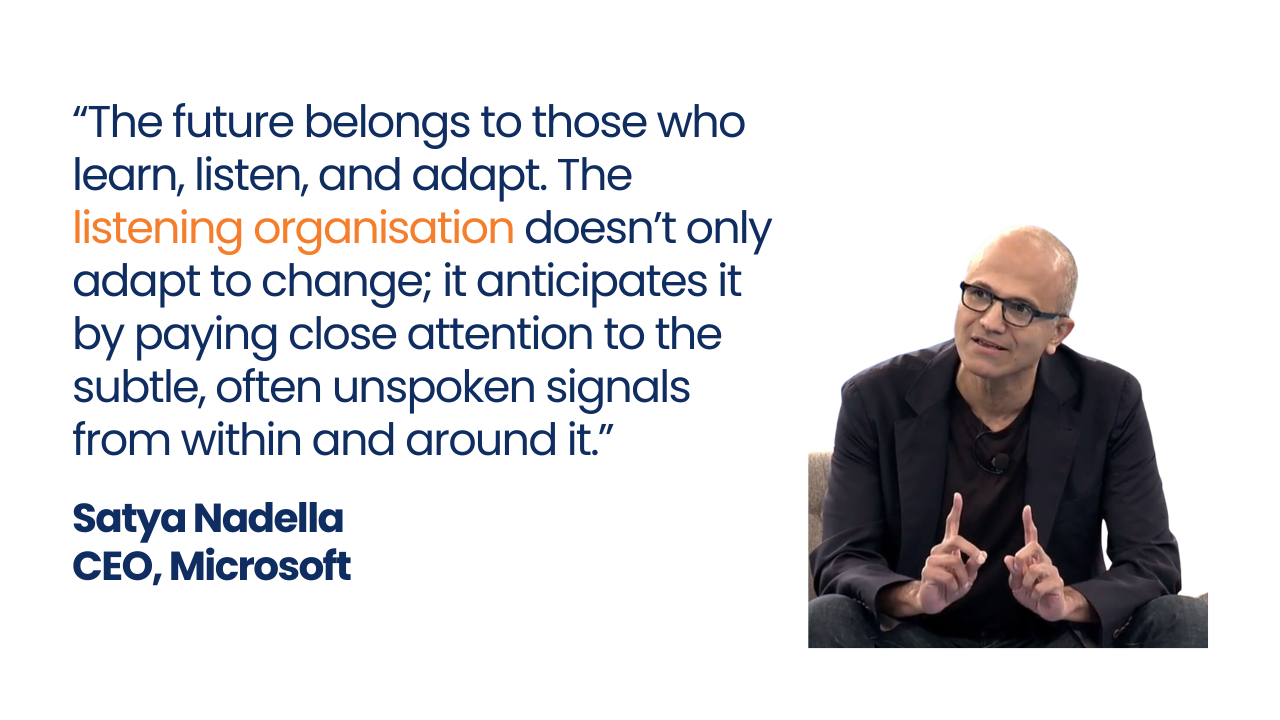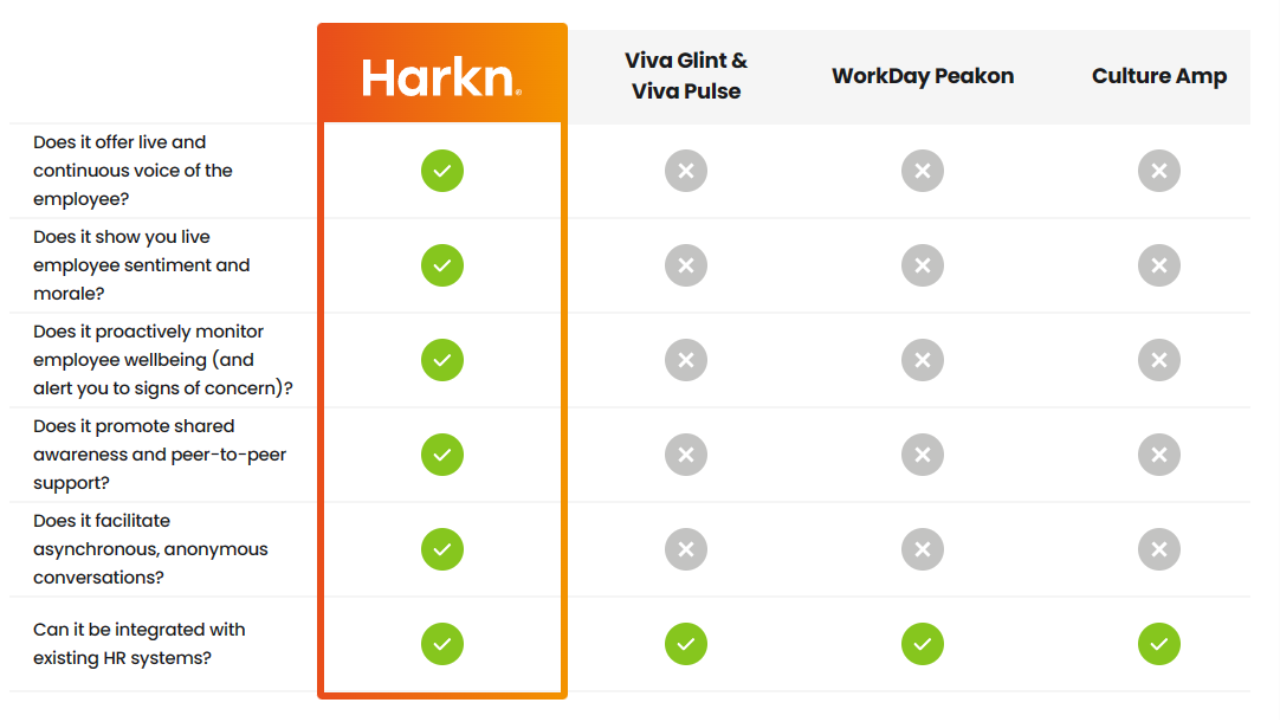The world of work has changed beyond recognition.
While the pandemic accelerated the shift to distributed and digital work, many underlying issues had been brewing long before March 2020.
The rise of AI and other technologies has added layers of complexity, making it increasingly difficult for organisations to keep up.
Whether these changes are seen as positive, negative, or somewhere in between, one fact remains clear:
Understanding the true state of life inside your organisation is harder than ever.
As demands rise, a disconnect has emerged between what businesses expect from their people and the state of employee engagement and wellbeing.
Traditional listening methods, like the engagement survey introduced in the 1920s, are now struggling to keep pace with the modern workplace.
It’s no surprise, then, that more and more businesses are looking to adopt continuous listening strategies to bridge these gaps and gain a real-time pulse on organisational life.
So, if you’re considering implementing continuous listening and want to know how to get the best out of it, this guide shows you how to build a successful strategy.

Part 1: Why is employee listening important?
Why listen? Many reasons will spring to mind, but most often they relate to individual behaviours – listening as a soft skill, rather than a strategic imperative.
But, as the above quote from Satya Nadella illustrates, this is the age of the listening organisation. We’re in a new era, one in which employee voice is recognised as crucial to business performance and every individual feels heard and valued.
In today’s fast-paced work environment, periodic listening methods are no longer sufficient. They provide a soundbite – a moment in time – that leaves organisations with outdated or incomplete information and employees feeling their views and opinions are not taken seriously.
Continuous listening, on the other hand, gives you a steady flow of real-time insights. Organisations and their leaders stay closely aligned with current reality and, as a result, are able to address emerging issues quickly.
Successfully executing your organisation's strategy relies on your ability to answer two critically important questions:
-
Where are we right now?
-
Where do we want to be?
Where you want to be is largely a question of vision, and it might not change much from year to year.
Where you are right now, however, is constantly evolving. Being able to answer this question accurately and dynamically guides immediate action and helps you successfully deliver on strategic goals.
That's the crucial advantage that continuous listening offers.
Knowing where you are right now involves more than just moment-in-time data. It means understanding the evolving experiences, sentiments, and challenges faced by your employees.
The Iceberg of Ignorance
In 1989, the consultant Sidney Yoshida produced a study called ‘The Iceberg of Ignorance.’ His research found that, across the board, company leadship was largely ignorant of their organisation’s real problems – or, in Yoshida’s words, they were only aware of ‘the tip of the iceberg.’
The study found that:
- 100% of front-line problems were known to front-line employees
- 74% were known to team leaders
- 9% were known to middle management
- 4% were known to top management
Information typically moves slowly upwards in large organisations. Bad news? Even more slowly.
This often results in leadership hearing only a small fraction of the contextual information that would help them make the right decisions at the right time.
That's where an effective live and continuous listening strategy makes all the difference.
"I learned that, the more senior I became, the harder it was to get unfiltered feedback from the team. Harkn takes my leadership team and me directly to the frontline of our business, allowing us to hear first-hand how our people are in terms of morale and wellbeing."
Ian MacKenzie
Chief Operations & Technology Officer, St. James's Place
The primary reason to embrace continuous listening, then, is speed to insight. Live and continuous listening gives you a real-time, accurate view of current reality and empowers agility and resilience at every level of your organisation.
The listening organisation anticipates change, adapts swiftly, and thrives in an ever-changing environment.
The benefits of live and continuous employee listening
When employees feel continuously listened to, they are more engaged, motivated, and committed to organisational goals. This, in turn, boosts productivity, innovation, and overall business performance.
Moreover, continuous listening fosters a culture of trust and inclusion. It increases a sense of belonging and significance amongst employees, enhancing morale and reducing turnover.
At Harkn, we firmly believe employee listening should never be a box-ticking exercise, but rather a strategic commitment to understanding and acting on employee feedback.
It’s crucial, then, to be clear about what you want to achieve with your employee listening strategy from the outset.
Unlock employee engagement & motivation
According to Gallup, 23% of employees are engaged globally.
Dismal as that statistic is, engagement is a deeply subjective concept, so let’s dig a little deeper.
The same report found that 90% of UK employees are unenthused about work, and 6 in 10 are quiet quitting. Meanwhile, Oak Engage reports that 37% of employees resist change.
So, what’s going on here?
Employees are feeling increasingly disconnected from their organisation’s culture and purpose. Central to this is a lack of trust, which has been eroded by decades of transactional listening. When people feel like you only involve them when you need something, they’re reluctant to deliver when you need them to.
Activating continuous listening makes employees feel heard and valued all the time – not just on special occasions.
Take change, for instance. When employees feel that their ideas and opinions are part of the decision-making process that affects them, they are far more likely to feel included in the process, better understand the context, and feel motivated to make it a success.
But when change is done to employees, not only will it be met with resistance, but people are less likely to fully understand the context behind the change and be empowered to make it a success.
Foster continuous learning & innovation
“The only sustainable competitive advantage is to learn faster than your competitors.”
Arie de Geus
Continuous listening is not just about giving your employees a voice; it’s also leadership’s opportunity to tap into the collective intelligence of their workforce.
Everyone’s always talking about innovation, and the moonshot ideas that propel the likes of Tesla and Google to new heights.
But innovation is not always about moonshot ideas. Changing the game and ripping up the rulebook is great sometimes, but it’s not the only way to achieve sustainable success.
If you want to become a future-fit business, start by seizing the opportunities for learning and improvement that lie in the everyday working environment.
Continuous listening – particularly open dialogue – fosters collective sensemaking at scale. This, in turn, empowers problem-solving and idea-sharing at every level of your business – not just in the boardroom.
To become a learning organisation, you must first become a listening organisation.
Improve employee wellbeing
Deloitte now attributes 40% of UK turnover costs to mental health problems, and poor mental wellbeing cost UK employers £56bn between 2020 and 2021.
We all know improving wellbeing is an urgent moral and business imperative, then, and many businesses are increasing investment in this area.
But most organisations are still not recognising wellbeing as deeply intertwined with listening, which often leads to misplaced investment.
University of Oxford’s recent research into wellbeing interventions makes clear where the problem lies. When the causes of poor wellbeing at work overwhelmingly stem from work itself, then solutions that seek to fix the individual are missing the point.
As well as redirecting your wellbeing efforts, you’ve got to speed them up.
The single biggest barrier to effective wellbeing strategies?
Organisations are not aware of who needs help quickly enough to offer meaningful support. There’s not a survey in the world that can pick out the one voice in 1,000 that needs urgent help right now.
Continuous listening empowers you to move from a reactive approach to workplace wellbeing to a proactive one driven by live employee voice and data-driven insights.
Deliver on diversity & inclusion
A culture of continuous listening brings all voices to the table, and the positive impact of this on inclusion is two-fold:
-
Employees feel heard, valued, and significant.
-
Leadership gain access to more diverse insights, helping to drive business success.
Like with wellbeing, organisations usually have great intentions with DEI but aren’t seeing enough meaningful progress.
Why is that?
Because building a truly inclusive workplace culture is simply not possible without continuous, anonymous feedback channels.
Consider these examples:
- A female employee might hesitate to voice her opinions during team meetings because she’s often interrupted or dismissed by colleagues.
- A neurodivergent employee may find it challenging to participate in fast-paced brainstorming sessions, as they need more time to process and articulate their thoughts.
- An employee from an ethnic minority group might avoid sharing their ideas in a public forum, fearing that their perspective will be dismissed or misunderstood due to cultural differences.
At the heart of inclusion is not shiny new initiatives, but a concerted effort to equalise voices and ensure everyone feels heard.
Strengthen your employer brand
As the world of work evolves, employees expect you to evolve with it.
This applies to both recruiting and retaining the very best talent, and it’s not isolated to Gen Z (despite the tidal wave of media coverage).
Everyone wants to feel heard, significant, and like they belong. They want opportunities for growth and development. They expect you to value their wellbeing and commitments outside of work.
When considering the move to live and continuous listening, it comes down to this…
Where do you want to hear how your employees really feel?
- In an exit interview, where challenges have already pushed an employee to leave.
- On Glassdoor or a similar public forum, where the context is unclear and your reputation could be damaged.
- Through secure, internal dialogue that empowers you to take immediate action based on what you hear.
We may be slightly biased, but we know which one we’d choose.
Part 2: Overcoming common employee listening challenges
The case for continuous employee listening should now be clear.
So, what needs to change in your current listening strategy to make it more effective? Is it just a case of minor adjustments, or making a bigger change?
Unfortunately, current listening methods like surveys – though useful as part of a wider strategy – are leaving significant gaps in your employee insights, often leading to missed opportunities and unaddressed issues.
The first step in building a successful listening strategy is to identify and avoid some of the mistakes we see most often in approaches:
Listening strategies that don't connect back to business goals
The most important part of any listening initiative is to understand why you’re doing it, what you're listening for, and what you hope to gain from it.
This means seeing listening as more than a one-off exercise, and adopting a new mindset that embraces employee voice as an ongoing asset.
Your objectives should include specific and holistic goals that connect your listening strategy to wider business outcomes.
For instance, you might be aiming to:
- Reduce waste and costs: By continuously listening to employee feedback, you can identify inefficiencies and areas of unnecessary expenditure. Addressing these issues leads to streamlined operations and cost savings, directly enhancing business performance and profitability.
- Improve customer experience: Use employee feedback to understand how internal processes and practices impact customer interactions. By aligning your listening strategy with customer satisfaction goals, you can make informed changes to enhance the customer experience, driving loyalty and business growth.
- Improve employee wellbeing: Use continuous listening to monitor and address employee wellbeing concerns promptly. This not only helps create a healthier workplace but also reduces absenteeism and enhances overall productivity, with a positive impact on your bottom line.
Listening strategies that wrongly assume psychological safety
Psychological safety doesn’t come from compassionate leadership. It doesn’t even come with a great, healthy culture.
Wherever you have hierarchy – and you always will in organisations – those of lower status will find it hard to speak truth to power.
If you’re in any doubt about this, take a look at Megan Reitz’s work. Her research identifies the full range of reasons why employees don’t speak up at work – and there’s many.
Here are just three examples based on her findings:
Fear of negative consequences: Employees often fear repercussions such as retaliation, damage to their career prospects, or strained relations with colleagues and superiors if they speak up. This fear can be particularly strong in hierarchical organisations with more pronounced power dynamics.
Lack of trust in leadership: When employees don’t trust that their leaders will handle their feedback responsibly or respectfully, they are much less likely to give it. This distrust can stem from past experiences where feedback was mishandled, leading employees to believe that speaking up is not worth the effort.
Perceived inefficiency: Employees might think their input is futile because it won’t lead to any meaningful change. Again, this perception usually stems from past experiences where feedback was ignored, fostering disengagement.
Understanding these barriers is essential for creating a culture where employees feel empowered to use their voices.
But the bottom line is this: You can’t guarantee psychological safety without anonymity.
Listening strategies that focus on one-time feedback collection
Putting out the call for feedback at a single point in time misses out on the critical moments when listening and response is most needed.
What’s more, it feels transactional to your people and further breaks down trust.
Continuous feedback channels help you capture the full spectrum of employee perspectives and experiences, so your people can tell you when something needs urgent attention before it escalates.
For example, imagine a new software implementation causing widespread frustration among employees due to unexpected bugs and usability issues.
With periodic feedback, these issues might not be highlighted until the next survey cycle – meanwhile, productivity is declining and dissatisfaction growing.
Continuous feedback, on the other hand, allows employees to report these problems in real time, so that IT can rectify them swiftly, maintaining workflow and morale.
As a different example, micromanaging behaviours from one team leader might be negatively impacting morale and performance. If you’re relying on periodic feedback, this issue could continue unchecked for months – all while engagement, productivity, and turnover suffer.
Continuous feedback empowers team members to voice their concerns promptly, allowing HR or leadership to intervene and provide further coaching to the manager.
Listening strategies that rely on ineffective feedback channels
We’ll elaborate more on this one in a minute, but the impact of listening strategies has become stifled by overreliance on outdated methods like the engagement survey.
Surveys fall short of meaningful impact because they are periodic and focus on what’s important in the company’s eyes, not what matters to employees. Effective listening should be an ecosystem that combines both employee-led and company-led feedback across a variety of channels, enabling real-time insights.
The latter approach empowers employees to share their thoughts, concerns, and ideas when they arise, not just when prompted.
By allowing employees to voice what matters most to them, organisations gain a more accurate and holistic understanding of their workforce, addressing issues and opportunities as they occur – not after the fact.

Why surveys are not an employee listening strategy
“At a time when organisations are facing wave after wave of disruption rather than occasional upheavals, the traditional survey approach is no longer sufficient. It should be supplemented by a continuous-listening strategy – a process driven by people analytics and supported by a people analytics team for capturing employee sentiment in both the short and long terms.”
Damonte et. Al, McKinsey, 2023
Surveys are fine for identifying and benchmarking top-level trends and patterns over time. What they are not is an employee listening strategy – especially if they’re the dominant method you’re using.
We cover this in more detail in our article, ‘Is Your Employee Engagement Survey Still Serving You?’, but here are a few reasons why surveys are falling short:
- They’re one way: Management dictate what’s asked, when it’s asked, and how employees can respond. And, if that’s not top-down enough, they then decide on how that feedback is shared and the actions that follow.
- They’re inefficient: It can take months to organise a survey, another few months to roll it out, and another few months to take action. By the time those actions come around, employees have moved on and the business will be operating in a new context. Pulse surveys might shorten this cycle, but ultimately they still enslave you to the same convoluted process.
- Employees don’t trust them: According to Gallup, 45% of employees think their survey responses can be traced back to them. Now, surveys are almost always anonymous. But the problem here lies in perception. This staggering statistic not only highlights a deep lack of trust, but it makes the validity of survey responses questionable.
- They breed disengagement: 92% of employees think no action will come from their survey responses. Seems crazy, right? After all, organisations run surveys because they want to make things better. But leadership has to pick out a handful of issues to focus on from large swathes of data, and then implement solutions in a top-down, one-size-fits-all manner. As a result, employees don’t recognise that action as addressing their need. They don’t feel heard, trust breaks down, and – ironically – they disengage.
Today’s workplace is fast-paced and dynamic, and it needs a listening strategy to match.
Part 3: What does a successful employee listening strategy need?
First and foremost, an effective continuous listening strategy requires two commitments:
Voice + response.
The first is a commitment to activating employee voices. This requires psychological safety (see above), clear communication around what you’re trying to achieve, and a thorough examination of all the means at your disposal to hear from employees.
The second is a commitment to response. This means establishing clear and undeniable accountability for listening to employees and ensuring they feel heard and valued in the process.
Central to both of these commitments, of course, is a clear mandate from leadership. So let’s explore that in a little more detail.
Leading the listening organisation
“Good leadership requires you to surround yourself with people of diverse perspectives who can disagree with you without fear of retaliation.”
Doris Kearns Goodwin
For a listening strategy to succeed, leaders need to work on two sets of characteristics: attitudinal and behavioural.
Attitudinal leadership characteristics
Having the right mindset towards employee listening is critical to its success, and nowhere is this truer than at the top of the organisation.
You have to want to listen. You need to believe employee listening is a crucial strategic advantage, and everyone in your business has something to contribute to its future.
To be clear, this doesn’t mean saying ‘yes’ to everything you hear. Leaders still need to lead, but they lead better when they listen.
The damaging ‘hero leader’ trap – the idea that leaders must be seen to have all the answers and asking for input is a sign of weakness – presents a significant barrier to effective listening strategies.
Leaders need to adopt an open mindset when engaging with employee feedback, too. It’s especially important to remember that critical feedback is almost never personal. Instead of responding defensively, respond with curiosity – what can you learn from it?
Take a look at Feedback (and Other Dirty Words) by Tamra Chandler and Laura Grealish for a deep dive into why leaders fear feedback and how to overcome it.
Behavioural leadership characteristics
“If openness is about valuing all perspectives because of the insights they provide, empathy is about valuing all perspectives because they come from people, and people matter.”
Krais et. Al, 2022
Leading the Listening Organisation
A 2022 study by Krais et. al found that – while line managers are vital – senior leadership has the biggest impact on the success of any listening strategy.
When leaders are seen to actively seek out a diverse range of perspectives and experiences, this behaviour is emulated by managers, who in turn demonstrate the importance of listening to employees. This makes role-modelling a powerful tool for culture change.
For leaders, this means treating employee listening as a key business objective – including measurement and reporting – and holding your managers accountable for listening.
It can also mean personal storytelling. When employees see leaders showing vulnerability and sharing their experiences, they feel more comfortable speaking up themselves.
So, leadership is vital in making your employee listening strategy a success. Once you have that clear mandate from the top, it’s time to implement your listening strategy.
Part 4: Implementing a continuous employee listening strategy
“The best time to plant a tree was 20 years ago. The second-best time is today.”
Harkn’s approach to continuous listening puts employee voice front and centre, harnessing a diverse range of insights to help shape your organisation’s culture and drive meaningful change.
It’s natural and intuitive, bringing employee-led and company-led feedback tightly together in a continuous feedback loop.

The critical components of a continuous listening strategy
1. Identify your gaps
Start with a thorough audit of your existing listening channels. Town halls, surveys, listening circles, 1-1s… include them all.
Ask yourself how often you’re hearing from employees through these channels, how many different voices you’re hearing, how safe they make it for employees to speak up, and what you’re learning from the response.
The central question is this: Are you getting a clear picture of day-to-day reality inside your firm?
If the answer is no, that’s the gap your strategy needs to plug.
2. Activate the right tools and technology
When it comes to the ‘how’ of your listening strategy, the most important thing is to ensure employees have access to upward, multidirectional communication channels they feel safe using.
More on tooling and technology in a minute.
3. Embrace a distributed approach to listening
Leaders often hesitate to activate continuous employee listening because they’re not sure how they’ll cope with the influx of insights – after all, surveys create enough work.
But it doesn’t work like this in reality.
Surveys operate on a centralised model that places a particularly heavy burden on HR and employee experience teams. Continuous listening, on the other hand, distributes that feedback across your entire organisation. Transparent, open dialogue empowers collective sensemaking and problem-solving at scale.
Your listening strategy, then, should empower both autonomy and collaboration to create a culture of continuous learning and improvement.
4. Make internal communications water-tight
There’s just one caveat in the distributed approach to continuous listening. While the listening process itself should be as distributed as possible, your communications should centralised and crystal clear.
Everyone – from the boardroom to the frontline – must understand exactly why you’re introducing your strategy and how it will work.
Water-tight communications should continue throughout the process, demonstrating that you're genuinely listening and proving the impact of continuous listening on organisational life.
5. Take action!
You won’t be able to act on everything you hear through continuous listening. But you might be surprised how much easier it is to implement positive changes than when you’re relying on periodic insights.
Our approach to listening is about exposing the ‘grit in the shoe’ of employees. In other words, the little things that make working life unnecessarily difficult.
In our experiences working with large and complex organisations, leaders often find it relatively easy to alleviate some of these problems once they’re made aware of them.
Over time, you will also identify recurring issues that require higher-level changes, and continuous listening will give you the live dialogue and data you need to make effective improvements.
6. Establish transparent feedback loops
Your listening strategy must pay as much attention to organisational response as it does to employee voice.
As we’ve already stated, this doesn’t have to mean immediate action – or any action at all if it’s not necessary. But you do need to let employees know they’ve been heard, acknowledge their insights, and tell them how they’ve contributed to change.
Never underestimate the importance of connecting actions back to feedback; this is the cornerstone of a successful continuous listening strategy.
Which employee listening technology does your business need?
The right tooling makes all the difference to how successful your listening strategy is.
As we said earlier in this article, employee listening is an ecosystem – and improving your approach doesn’t have to mean throwing out all your existing ways of hearing from your people.
But if you want to gain that all-important pulse on reality inside your organisation, you need tooling that can fill the gaps.
Your listening technology should be live, continuous, and always anonymous. It should increase your speed to insight, give you access to feedback you wouldn’t hear anywhere else, and give a voice to those who wouldn’t otherwise have one.
Every organisation is different, and choosing the right solution for your needs can be tricky.
Our guide to listening tools clearly outlines what you get from various solutions, including Harkn, major survey providers, and wellbeing apps.

What will you achieve with continuous employee listening?
“The age of the listening organisation is upon us, and it’s not just about gathering data or feedback. It’s about understanding the story behind the data. It’s about empathy, understanding, and most importantly, taking action based on what you’ve heard.”
Bréne Brown
We’ve covered a lot of ground in this article. If you only take away two things, make it these:
-
The most powerful benefit of continuous listening is speed to insight, empowering a clearer view of reality inside your organisation.
-
Any successful listening strategy includes a commitment to both voice and response, bringing company-led feedback and employee-led feedback together in a continuous loop.
We hope this guide has given you the information and inspiration you need to get started with continuous listening.
If you have any questions or want to explore whether Harkn would be a good fit for your organisation, we’re always available for a more in-depth chat.
Good luck!





